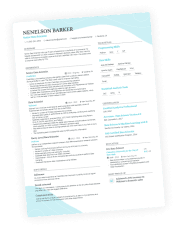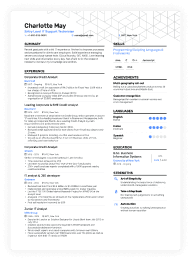Before printing your resume, there are certain aspects of paper quality we need to consider first. Believe it or not, the paper you choose can leave the recruiter thinking you’re professional or laxed, meticulous or unfocused, thorough or thoughtless. Resumes get noticed by impression – the paper you choose is another part of that impression mark. So, what paper do you need? Find out below.
Why do I need to worry about resume paper?
As with all stylistic choices for your resume (including resume length and resume color) the resume paper you use contribute to the impression you leave on the recruiter. Using high-quality and eye-catching paper can be the difference between getting selected from the applicant pool and not being selected. Recruiters report poor format and paper choices can cause lead to an automatic rejection of your resume.
The reality is, most resume selection process comes with a degree of impression marking. If the recruiter doesn’t like the style choices you’ve made, this can lead to you ending up in the ‘No’ pile no matter what your content is. Especially for the organisations that receive countless resumes every day, you need to make the decision as easy as possible. This means appealing to the recruiter with everything you’ve gone – right down to your resume paper.
When will I need a physical copy of my resume?
Having a physical copy of your resume is important for those situations you come in personal contact with recruiters. Namely, careers fairs and your interview.
Careers Fair
A careers fair is the perfect opportunity to pass your resume to recruiters in a physical form. When Sam was making her career change from banking to Spotify, recruiters at a job fair told her “We don’t usually take resumes, but we’ll take this one”. Now, she works at Spotify in a career she loves. The same could be true for you.

As we see from Sam’s story, even if recruiters don’t generally take resumes, you can craft one that leaves an impression that makes them change their mind. Your resume paper can similarly play into this impact.
Tip: Send a follow-up email to the recruiter to seal the deal!
Interview
Some recruiters may ask you to bring a copy of your resume to the interview. Even if they don’t ask you to, do it anyway! This can be used as a reference for them in the questions they ask you and so on.
The four aspects to consider when choosing resume paper
Paper Weight
Paper weight has a number of practical considerations behind it. Think of the following situation:
You’ve spent a number of days crafting the perfectly tailored resume for a new position. You’ve spent some time reviewing your resume and ensuring it has purpose. The time has come for you to put it into action and bring your resume to a careers fair. After printing, you notice the edges of your resume sections are blurred and when held up to light, you can see right through all of your content.
What can help you avoid all of these problems? Picking the appropriate paper weight. In general, resume paper comes in three standardized weights: 20 lbs, 24 lbs, and 32 lbs.
20lbs paper is what your typical at-home printer will have. 24lbs is slightly heavier, thicker to-the-touch, and is more opaque. 32 lbs paper is the thickest paper you’ll find before you venture into card weights (which are really not needed).
In general, I’d recommend using 24 lbs paper for printing your resume. It’s heavy enough to prevent leaking, and is different enough from everyday printer paper to leave an impression on the recruiter. This paper weight is also suitable for printing on both sides of the page if you’re looking to reduce the amount of pages you use. Keep in mind when printing on both sides of a page that you may need to include a resume header on both sides. Consider numbering your pages in this circumstance too.

Paper Color
The traditional paper color applicants use is, you guessed it, white. However, there are variations on paper color you may want to explore. Four color options to consider are:
- White
- Off-white (ivory)
The color of your resume paper has ramifications for the content that is being printed on it. For example, if you’re using consistent black font with minimal graphics and white spacing, an off-white (ivory) paper color may set you apart from other applicants. This color is typical for printing booklets and flyers, and thus has a professional theme associated. White paper is best when your content uses many different colors and graphic styles.
For example, Adam’s IT resume uses a yellow-and-blue font with a pie-chart graphic. This stands out best against a white background as ivory paper can appear yellow under certain lighting.

You may want to consider using pink or blue paper be more eye-catching. This is most appropriate when using a traditional resume layout with minimal design and a focus on simple text. In these, you can use the color of your resume paper to differentiate yourself from other applicants.
Overall, the best choice to go with in my opinion is white. It gives you the most freedom, and is in-line with most recruiters expectations. Things to consider when picking your paper color are the color of your font, and and images you may be including.
Tip: Want control over the color scheme of your resume? Try Enhancv’s resume builder to create a visual resume just like Adam’s.
Paper Texture
The texture of your resume paper will influence how it feels in the hands of the recruiter. This also affects how your printed content sits on the paper. In general, recruiters will expect plain resume paper textures (i.e., the paper texture you think of automatically). What you may want to look out for is the cotton content. The higher cotton content your resume paper has, the smoother it feels to touch.
Other paper textures include parchment paper (which has an old-fashioned style), laid paper (which comes embossed) and granite paper (slightly darker).

Paper Size
In contrast to our previous three aspects, there’s little room for debate on the paper size you should use. There are few circumstances recruiters will look favorably on extraordinarily large resumes (or extraordinarily small resumes) as they are practically inconvenient. Stick to the typical 8.5 x 11in resume paper size to leave the best impression.

What’s the gold standard of resume paper?
The paper you print your resume on can influence the impression you leave on the recruiter. Poor quality, thin, and easily malleable paper can easily get ignored and tarnished. High-quality paper that acts as the perfect backdrop to your content can, on the other hand, project a professional image. Commonly, 32 lbs white paper with a high cotton content and plain resume texture is the way to go. There are other options to try for those nonconventional positions, too. No matter what paper you choose, you can use Enhancv’s builder to perfect your content and choose the most appropriate color palette, format, and visuals.
Make one that's truly you.



